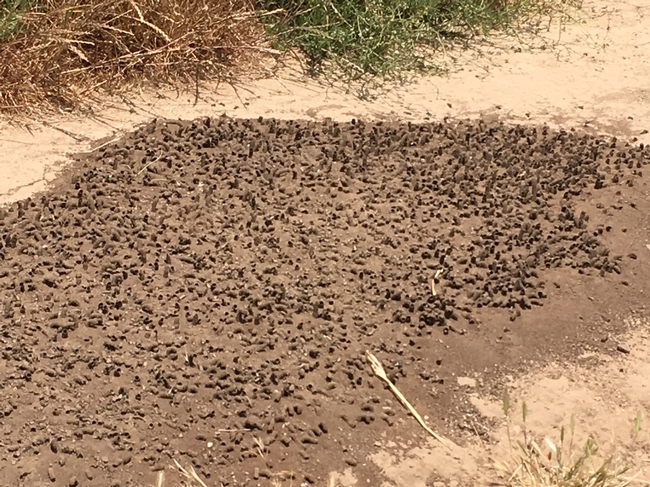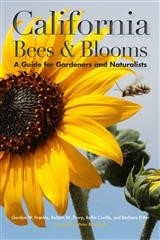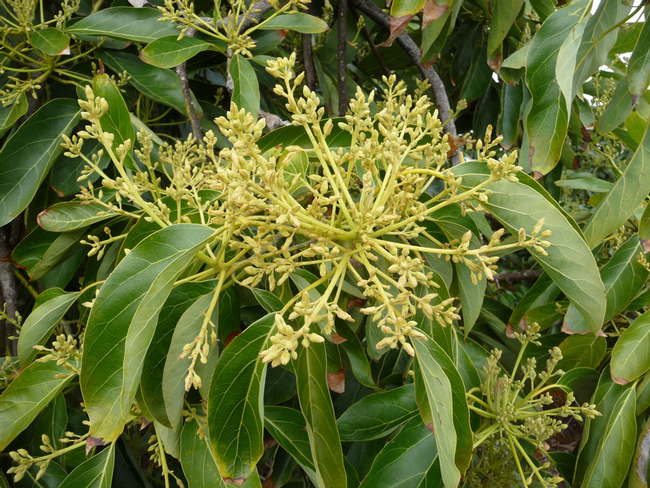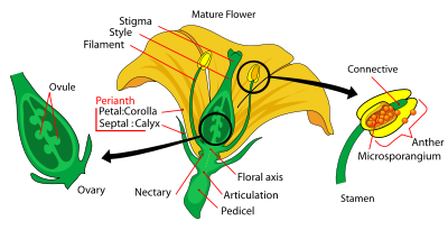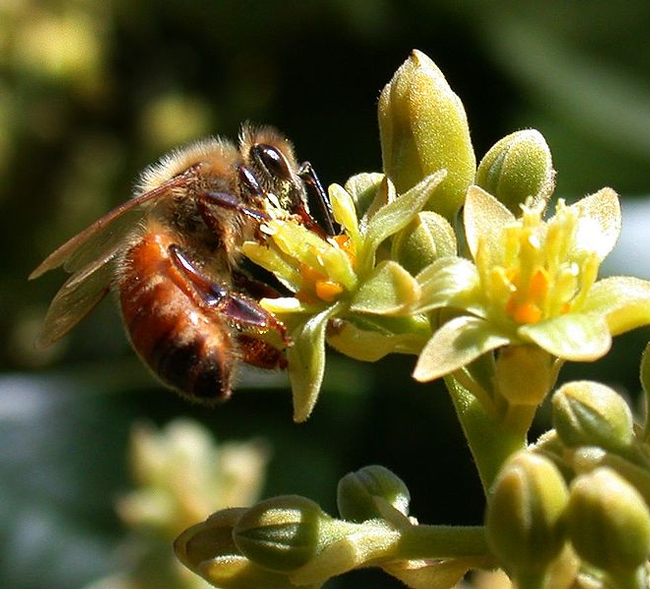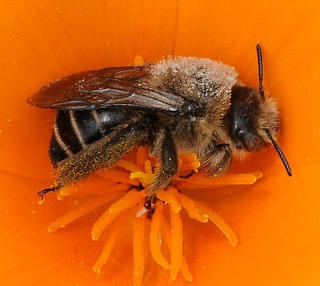- Author: Ben Faber
Nearly 1600 species of native bees can be found in California's rich ecosystems; this colorful pocket-sized card set will help you identify 24 of the most common bees found in urban gardens and landscapes.
Using this card set, you'll be able to identify bees on the wing to the genus level. Included for each featured bee are color photographs, a general description of appearance, the distribution and richness, flight season, nesting habits, floral hosts, and how each transports pollen.
Also included is a brief description and illustration of the anatomy of a bee, a glossary, bibliography, and online resources so you can delve deeper into the lives of these fascinating social insects.
Designed as a companion to the book California Bees and Blooms. This 3-1/2" x 5-1/4" card set is spiral bound and printed on sturdy laminated paper to hold up to rough service in the field.
CB & B also has lists of plants attractive to different bee species
Get this and "California Bees and Blooms" at :
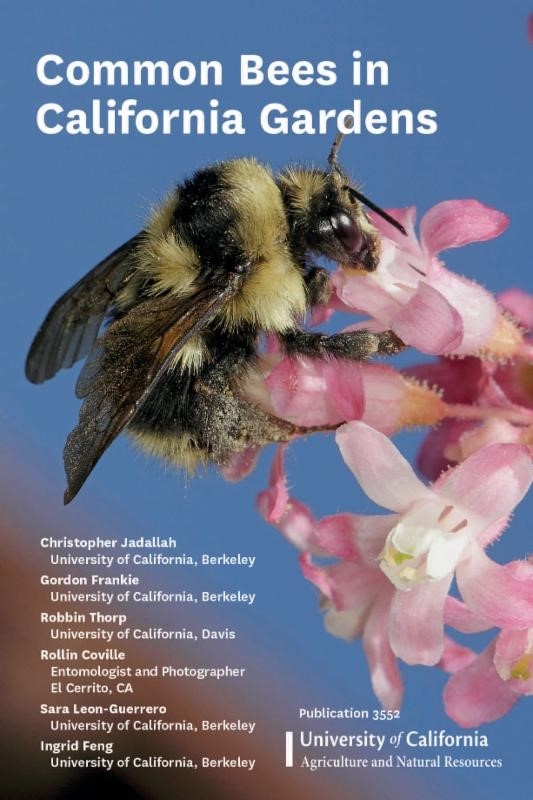
- Author: Ben Faber
You always wanted to know what pollinated rambutan, litchi, blueberries and all those other plants dependent on insect pollen movement? O yes, and also what is pollinating avocado?
Insect Pollination Of Cultivated Crop Plants
by S.E. McGregor, USDA
Originally published 1976
The First and Only Virtual Beekeeping Book Updated Continuously.
Additions listed by crop and date.
This book is out-of-print, but can be found on-line at ABE Books and then you can get the images that are missing from the online version of the book
https://www.ars.usda.gov/ARSUserFiles/20220500/OnlinePollinationHandbook.pdf
This is an old book with a lot of old information, but a lot of it is still good. There is definitely more up-to-date information, but this is a good starting point. For avocado, another good source, or course is AvocadoSource which also has quite a number of articles on pollination of other tree species
http://www.avocadosource.com/search.asp
Recently a group of UC Riverside researchers met to align themselves around the topic of pollination - The biology, effects, interactions of the various pollinator and pollinizers and how they are affected by our environment and how we might be able to manage them better. The participants in this pollination group have all manner of expertise and hopefully their interaction will bring a synergy of understanding to this very complicated subject.
Photos: Syrphid (hover) fly, bumblebee, honeybee, thrips carrying pollen
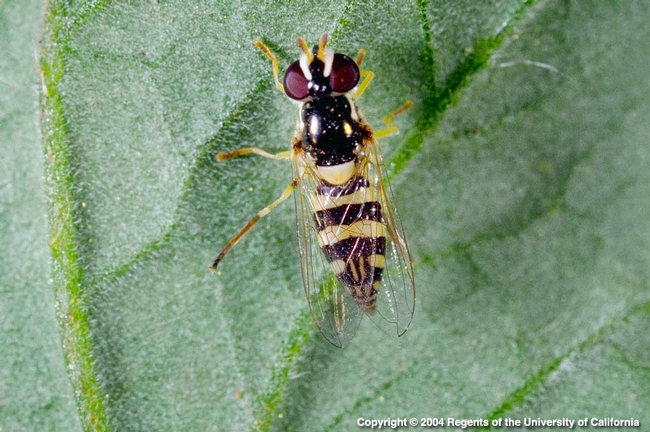
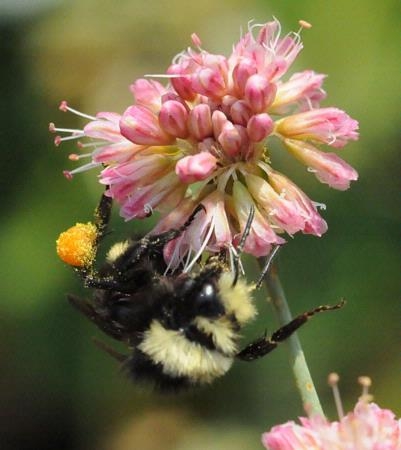
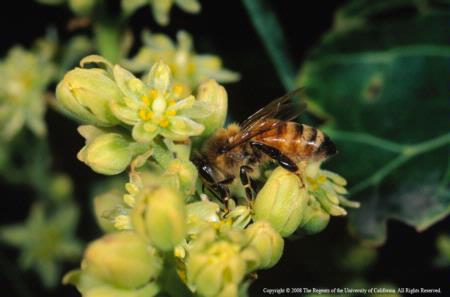
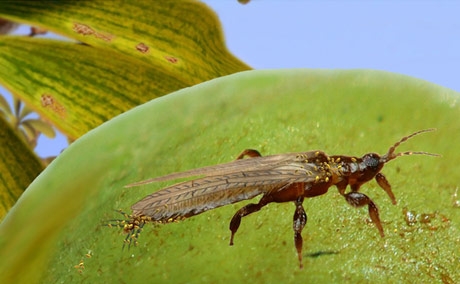
- Author: Sonia Rios
Avocado trees can appear completely covered with flowers. A typical full grown healthy avocado tree in California can produce up to a million flowers a year, but, on the average, fewer than 200 flowers per tree will set fruit that will hold and develop to maturity and harvest (about 10,000 lbs/acre, or less). Upon occasion, we have seen some groves with trees setting an average of 500 flowers per tree (25,000 lbs/acre), but this is rare. More commonly, only 100 flowers (or less) per tree will set and hold fruit to maturity (5,000 lbs/acre or less), much to the distress of growers (Bender 2013). Flowering is typically spread over six to eight weeks.
The avocado flower has both functional male and female organs. The male floral organ, which produces pollen, is comprised of the anthers and stamens. The female floral organ is comprised of the stigma (which receives the pollen), style and the ovary. The flowers are small (10 mm diameter). The flowers are usually only open for 2–6 hours, then close and open again for 2–6 hours on the second day. When a flower opens for a second time, it produces pollen and the stigma is not receptive. Flowers then close and remain closed. Flowers will usually be one sex in the morning, closed in the middle of the day and the opposite sex in the afternoon. The timing of the sex phases can be quite defined, but environmental conditions will affect the timing and duration of the male and female phases. The mature tree can produce in excess of a million flowers during the flowering period.
Avocado cultivars are classified in two groups (A or B) based upon their flowering behavior. In the type ‘A' cultivars, the female organs are receptive to pollen in the morning and the pollen is released in the afternoon. Unfortunately, most of the currently available "B" varieties are classed as "greenskins", which return less to growers. In the type B'cultivars, the pollen is released in the morning, while the female organs are receptive in the afternoon. Type A cultivars include: Hass, Gwen, Lamb Hass, Pinkerton, Reed, Gem, and Harvest. Type B cultivars include: Bacon, Ettinger, Fuerte, Sharwill, Sir Prize, Walter Hole, Zutano, Marvel and Nobel. Both type. It is believed that the interplanting of complementary flower types can boost fruit set and therefore yield by making pollen available. The separation in time of the male and female phases has led most observers to believe that a vector or "pollinator" is needed to move pollen from one flower to another.
Steps to take to Improve Pollination (Bender 2014):
1. Bring beehives into the grove. The University of California farm advisors have usually recommended 1 – 2 strong hives per acre, but Ish-Am (2000) suggests that 1 hive is rarely sufficient, and in many cases 4 hives are required. California growers usually have to rent hives (in 2002 hive rentals averaged $42 per hive), but sometimes beekeepers will drop a load of 80 hives for free if the grower has good bee forage nearby. Bees should have water available; floating boards on ponds or reservoirs enables them to land and drink without drowning.
2. Add pollinizers to the grove. Ish-Am recommends a pollinizer tree row be located at least every fourth row. Some growers in California use pollinizers as wind-breaks around the grove, and some replace thinned-out trees with pollinizers.
3. Keep the orchard open. Direct sunlight should reach the lower branches of each tree in order for the trees to produce a “wall” of flowers down the ground. In avocado production, this can only be accomplished by pruning the upper branches on a yearly basis. Keeping open channels through the grove encourages the flight of bees.
4. Other types of bees? Bumblebees have been reported to increase yield in avocados in Israel where honeybee populations were low. New World Carniolan bees have been used in an experiment in San Diego County for pollination: results were inconclusive as to whether they increased yield compared to Italian honeybees, but it was found that they gather more nectar from avocado (Fetscher et al. 2000). Work with these bees, and other wild bees, may eventually reveal a more efficient pollinator for avocado.
- Author: Stephanie Parreira
Pollinator Week, June 19–25, 2017: Bee Knowledgeable!
UC Statewide IPM Program
Remember, the plant that contributes the pollen is the pollenizer (sometimes pollinzer or polleniser) and the animal that moves the pollen is the pollinator (sometimes pollenator) which doesn'talways have to be a bee, but can be another insect, bat, bird or butterfly or ....
Bees are the most important pollinators of California agriculture—helping us grow field crops, fruits, nuts, and vegetables. Honey bees receive most of the credit for crop pollination, but many other kinds of bees play an important role as well. There are 1600 species of bees in California! Take time during Pollinator Week to learn about the different kinds of bees and what you can do to help them flourish.
Why should I care about other kinds of bees?
Bees other than honey bees contribute significantly to crop pollination. For example, alfalfa pollination by alfalfa leafcutter bees is worth $7 billion per year in the United States. Other bees can also boost the result of honey bee pollination—in almond orchards, honey bees are more effective when orchard mason bees are present. The more bee species, the merrier the harvest!
While growers often rent honey bee colonies to pollinate their crops, some wild bees pollinate certain crops even better than honey bees do. For instance, bumble bees are more effective pollinators of tomato because they do something honey bees do not: they shake pollen out of flowers with a technique known as buzz pollination. Likewise, native squash bees are better pollinators of cucurbits—unlike honey bees, they start work earlier in the day, and males even sleep in flowers overnight.
How can I help honey bees and other bees?
When it comes to land management and pest management practices, some bees need more accommodations than others. That's why it is important to know what bees are present in your area and important to your crop, and plan for their needs. Use this bee monitoring guide from the University of California to identify the bees present on your farm.
You can help all kinds of bees by using integrated pest management (IPM). This means using nonchemical pest management methods (cultural, mechanical and biological control), monitoring for pests to determine whether a pesticide is needed, and choosing pesticides that are less toxic to bees whenever possible. Check out the UC IPM Bee Precaution Pesticide Ratings to learn about the risks different pesticides pose to honey bees and other bees, and follow the Best Management Practices To Protect Bees From Pesticides.
Bees also need plenty of food to stay healthy and abundant. Plant flowers that provide nectar and pollen throughout the year. See the planting resources below to find out which plants provide year-round food for specific types of bees.
Like honey bees, native bees need nesting areas to thrive. Bumble bees, squash bees, and other bees nest underground. Ground-nesting bees may require modified tilling practices (such as tilling fields no more than 6 inches deep for squash bees) or no-till management to survive. For aboveground nesters like carpenter bees and mason bees, consider planting hedgerows or placing tunnel-filled wooden blocks around the field. See the habitat resources below for more information about native bee nesting in agricultural areas.
Enjoy your “beesearch!”
Bee Habitat Resources
- Habitat for Bees and Beneficials
- Managing Wild Bees for Crop Pollination
- Native Bee Nest Locations in Agricultural Landscapes
- Farming for Bees: Guidelines for Providing Native Bee Habitat on Farms
- Hedgerow Planting for Pollinators: Central Valley, Central Coast, Southern California
- Conservation Cover for Pollinators: Central Valley, Central Coast, Southern California
- The Integrated Crop Pollination Project: Tools for Growers
Sources
- Insect Pollinated Crops, Insect Pollinators and U.S. Agriculture: Trend Analysis of Aggregate Data for the Period 1992–2009.
- Native bees are a rich natural resource in urban California gardens. (PDF)
- Honey bees are more effective at pollinating almonds when other species of bees are present.
- http://cagardenweb.ucanr.edu/General/Encouraging_Native_Bees_-_Other_Pollinators/
- How to Attract and Maintain Pollinators in Your Garden - https://anrcatalog.ucanr.edu/pdf/8498.pdf
Bombus vosnesenskii ( say that fast) a CA native bumble bee buz pollinating a lavendar (not CA native) flower (photo: Kathy Keatley Garvey)
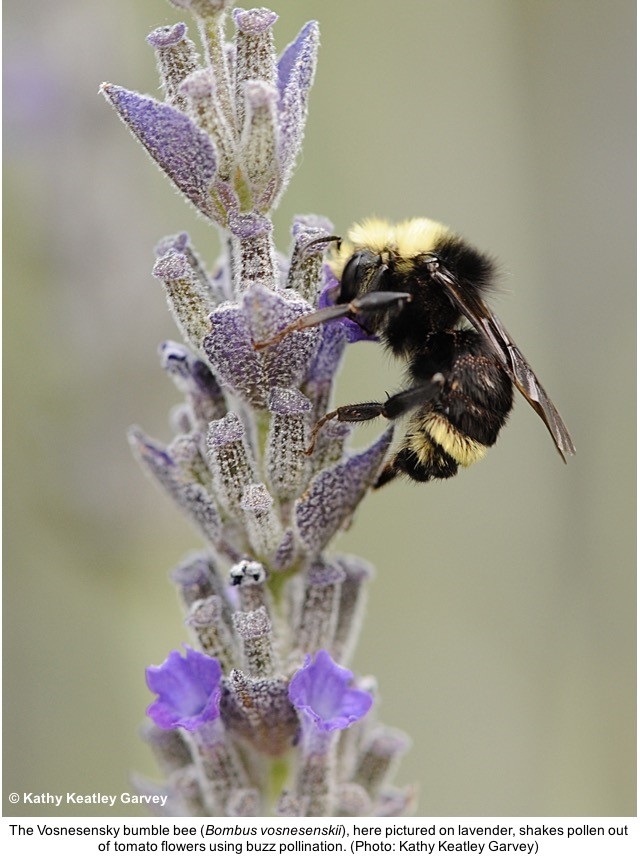

- Author: Ben Faber
Diadasia bituberculata – Digger Bee
The hills are alive with the sound of BEE-EEZZE. And often they are found crawling on the ground, as is the case of Digger Bees. At this time of year, they might be seen along the margins of avocado orchards, near hiking trails or in undisturbed areas of citrus orchards. They are called Digger Bees commonly, but this is just a generic name for a large group of bees that nest in the ground. There are many genera and species and because of the general lack of study of these bees they are lumped under the name Digger for lack of any greater knowledge and naming of them. In the case of this bee find reported here, they are possibly Diadasia bituberculata – as suggested by Robin Thorpe, retired UCD entomologist. They are uncommon in the rest of the world, but found here in California and western US.
There are several kinds of small hairy or metallic bees that dig into the soil to nest, hence the common name, digger bees. They are a diverse group that comes from different families and the term digger bee can include the andrenid bees, halictid bees, and colletid bees such as the plasterer and yellow-faced bees. These are solitary bees and native pollinators that are active early in the season. Each female digs a cylindrical underground tunnel as a nest where she reproduces (as opposed to social bees such as honey bees where only the queen reproduces and maintains a colony with the help of sterile workers). Although solitary, they form colonies that may have several hundred nests in one spot, but all nests are independently owned.
The subterranean nest is provisioned with a mixture of nectar and pollen collected from nearby flowering plants. This "bee-bread" is food for the bee's offspring (larvae) that develop in the underground chamber and emerge as adults the following year.
Digger bees are 1/4 to 1/2-inch-long and variable in color (mostly shiny metallic or dark, but some with markings of white, yellow or reddish brown). There is one generation of digger bees per summer and once the adults finish perpetuating the species by laying eggs of the next generation there will be no activity till the following spring.
Digger bee nests are commonly located in areas where grass and mulch are scarse, either from too much shade, previous drought conditions or other stress. Most of them like to fly around their airspace at different times of the day, something to do with mating, air temperature or staking territory. They often travel great distances to forage.
The threat of being stung by digger bees is unlikely. The bees are docile and not likely to sting unless handled or threatened. There is no nest guarding behavior or attack behavior like there is with social insects such as honey bees and yellowjacket wasps.
Image: Digger Bee "Colony", Thanks to Pest Control Adviser Jane Delahoyde's friend.
